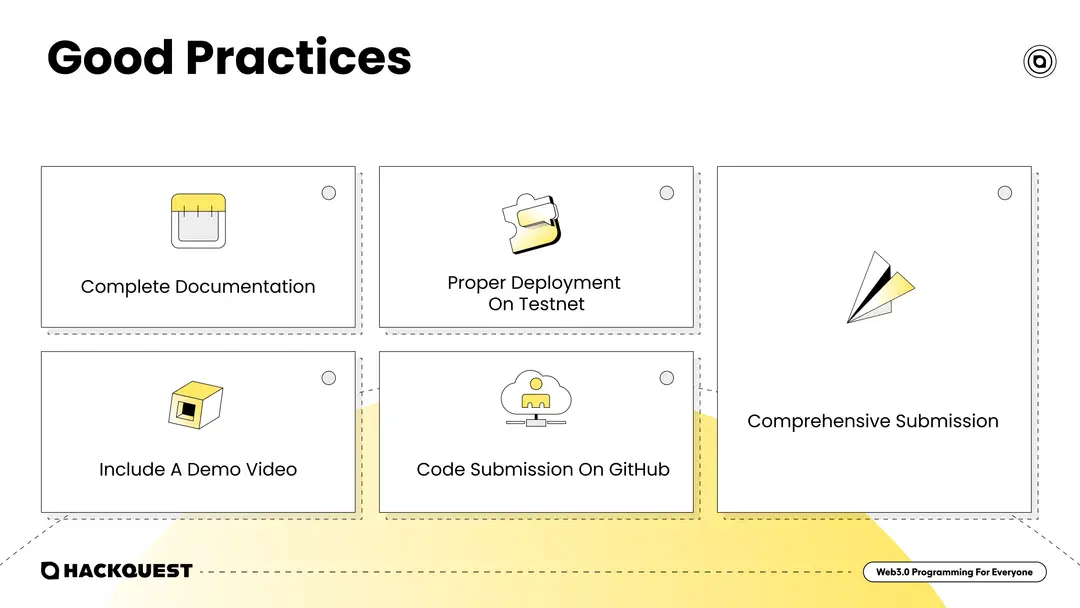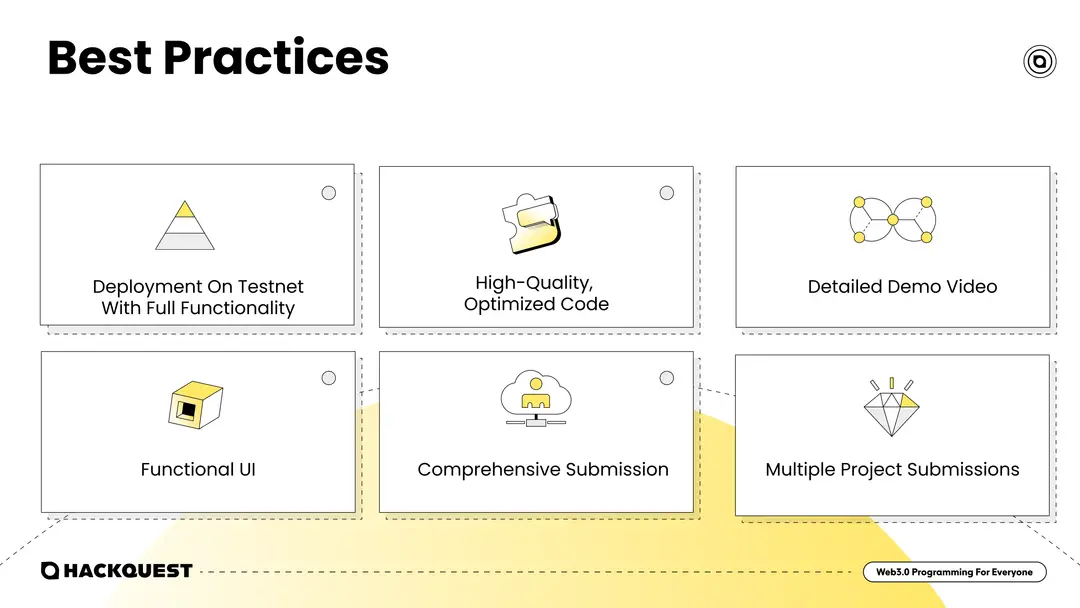Back
Best Practices for Successful Web3 Hackathon Project Submissions
Others
By HackQuest
Oct 20,20244 min read
When you're gearing up for a hackathon or submitting your Web3 project, following these best practices can make all the difference between standing out and getting lost in the crowd. We've put together a list of essential tips—covering everything from documentation to deployment—to help you deliver a polished, professional submission that grabs attention and maximizes your chances of success.

Good Practices ✅
1.Complete Documentation
●Include a README.md in GitHub with a clear overview of the project, the technology stack, and detailed instructions for installation and usage.
●Make sure to add the deployed contract address and the blockchain network used.
2.Proper Deployment on Testnet
●Deploy your smart contracts on the Testnet of the specific blockchain (e.g., Ethereum, Linea, Neo, etc). Ensure that your deployment is successful and live.
●Provide a Scan URL (e.g., Etherscan for Ethereum-based projects) to verify the contract deployment.
3.Include a Demo Video
●Record a demo video (within 2-5 minutes) that demonstrates the key features of your project and the problem it solves.
●Ensure that the demo showcases the contract interaction, UI (if applicable), and functionality of your dApp.
4.Code Submission on GitHub
●Push your project code to GitHub with public access, ensuring your repository is well-organized and easy to navigate. And have a proper commit history.
●Include all necessary project files, such as smart contracts, frontend code, and deployment scripts.
5.Comprehensive Submission
●Ensure your submission includes the contract address, Scan URL, demo video, GitHub link, and live link (if available).

Best Practices 🍀
(COVERS ALL THE POINTS IN GOOD PRACTICES &…)
1.Deployment on Testnet with Full Functionality
●Ensure your contract is deployed on a recognized Testnet (e.g., Sepolia, Goerli for Ethereum) and that users can interact with the contract seamlessly.
●Provide both the Scan URL and a block explorer link to demonstrate that the contract is fully functional.
2.High-Quality, Optimized Code
●Write well-structured, commented, and optimized code for both the smart contract and front end.
●Follow best blockchain development practices, including security checks for smart contracts (e.g., using OpenZeppelin for secure contracts).
3.Detailed Demo Video
●In your demo, highlight how the project addresses the problem and walk through the smart contract's functionality.
●Showcase the deployment process, contract interaction, and live demo of your app’s features.
4.Functional UI
●Ensure that your UI is user-friendly and allows interaction with your smart contract.
●If you have a live link to the front end, include it (e.g., hosted on Vercel, Netlify, etc.).
5.Comprehensive Submission
●If your project uses APIs or third-party integrations, provide access details or explanations in the README and project description.
6.Multiple Project Submissions
●You are allowed to submit multiple projects, but each must meet the basic quality standards. Ensure each project has its own clear and independent use case.

1.Not Deploying on Testnet
●Failing to deploy your smart contract on a Testnet or not providing the Scan URL for verification is a critical mistake.
●Submissions without proper deployment will likely be disqualified.
●Deploying your project on the wrong blockchain (e.g., submitting a project on Polygon when the hackathon is focused on AIA Chain) will also lead to disqualification.
2.Incomplete Information
●Missing out on essential details like the contract address, Scan URL, or demo video can lead to disqualification.
●Make sure all submission requirements (GitHub repo, demo video, live link) are provided.
3.Spammy or Duplicated Submissions
●Submitting old projects or code is allowed, but make sure they are deployed on the correct chain and align with the hackathon's theme and judging criteria.
●Submitting the same project multiple times for the same hackathon with only minor changes is not permitted.
●Projects that don't show meaningful adaptation or fall outside the hackathon’s theme will be disqualified.
4.Poor-Quality UI/UX
●Submitting a project without a functional or navigable UI will hurt your chances.
●Even if you only focus on smart contracts, ensure you include a way to interact with them (e.g., through a simple frontend or a script).
5.Low-effort or Non-Functional Submissions
●Submissions with broken code, non-functional contracts, or incomplete features will not be considered.
●Projects that don’t interact properly with the blockchain or Testnet will be disqualified.

Stay ahead of the game and boost your hackathon success by staying connected! Follow HackQuest on Twitter for the latest hackathon news, resources, and tips to help you excel. Join the conversation and get involved in a community that’s shaping the future of Web3 development.